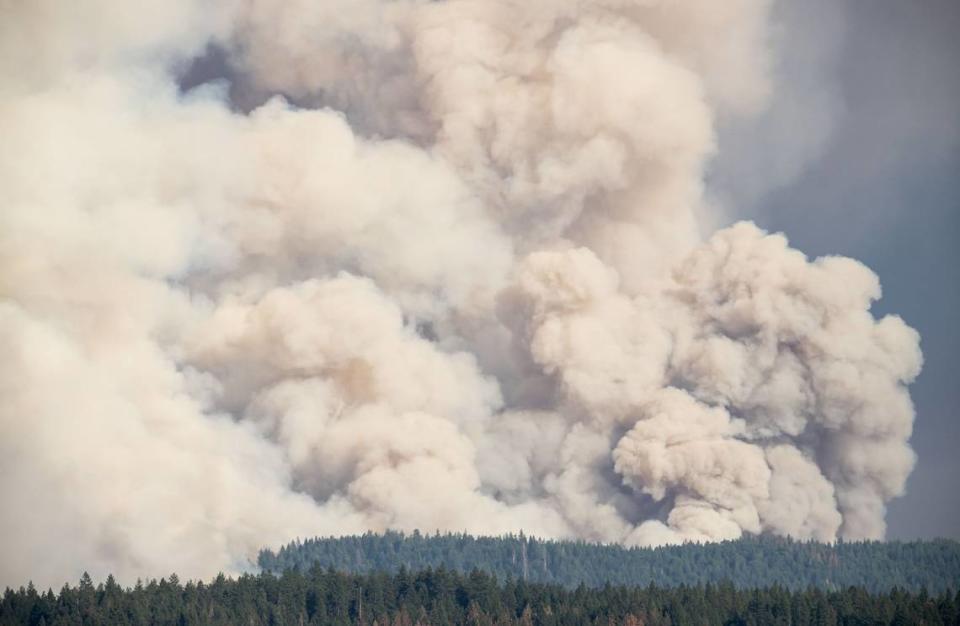These 11 California counties are most at risk for wildfires, FEMA map shows. Here’s where
California is no stranger to wildfires — and some regions are more at risk than others.
While most wildfires occur between April and October, “California faces the risk of wildfires all year now” due to the warmer and drier weather patterns, according to CalMatters.
Using data collected in March 2023 and risk assessments, the Federal Emergency Management Agency has created a map that shows which counties across the United States are the most at risk for wildfires.
FEMA looked at expected annual loss, which calculates the costs of natural disasters, as well as social vulnerability, which determines how social groups will be affected by disasters. The agency also explored community resilience — how well people prepare for natural disasters and how quickly communities bounce back following the event.
FEMA used these factors to rate a county’s wildfire risk from very low, relatively low, relatively moderate, relatively high to very high.
Which California counties are more at risk for wildfires?
According to FEMA’s map, these 11 California counties are at higher risk for wildfires:
1. Riverside County
Risk index: Very high
Overall rating of wildfire risks: 100%
Expected annual loss from wildfires: $319 million
Frequency: 2.4% chance per year
Historic loss ratio: Relatively low
2. San Diego County
Risk index: Very high
Overall rating: 100%
Expected annual loss from wildfires: $382 million
Frequency: 2.7% chance per year
Historic loss ratio: Relatively low
3. San Bernardino County
Risk index: Very high
Overall rating: 99.9%
Expected annual loss from wildfires: $134 million
Frequency: 0.97% chance per year
Historic loss ratio: Relatively low
4. Los Angeles County
Risk index: Very high
Overall rating: 99.9%
Expected annual loss from wildfires: $109 million
Frequency: 0.8% chance per year
Historic loss ratio: Relatively moderate
5. Ventura County
Risk index: Relatively high
Overall rating: 99.8%
Expected annual loss from wildfires: $48 million
Frequency: 1.3% chance per year
Historic loss ratio: Relatively low
6. Orange County
Risk index: Relatively high
Overall rating: 99.8%
Expected annual loss from wildfires: $50 million
Frequency: 1.5% chance per year
Historic loss ratio: Relatively low
7. Kern County
Risk index: Relatively high
Overall rating: 99.7%
Expected annual loss from wildfire: $28 million
Frequency: 0.7% chance per year
Historic loss ratio: Relatively moderate
8. Madera County
Risk index: Relatively high
Overall rating: 99.6%
Expected annual loss from wildfires: $20 million
Frequency: 0.8% chance per year
Historic loss ratio: Relatively moderate
9. Santa Barbara County
Risk index: Relatively high
Overall rating: 99.5%
Expected annual loss from wildfires: $24 million
Frequency: 0.8% chance per year
Historic loss ratio: Relatively moderate
10. Tuolumne County
Risk index: Relatively high
Overall rating: 99.5%
Expected annual loss from wildfires: $21 million
Frequency: 0.96% chance per year
Historic loss ratio: Relatively low
11. Calaveras County
Risk index: Relatively high
Overall rating: 99.4%
Expected annual loss from wildfires: $22 million
Frequency: 0.9% chance per year
Historic loss ratio: Relatively moderate
Other counties across California were rated at lower risks of wildfires.

Why are wildfires in California experience getting worse?
According to the California Air Resources Board, climate change — primarily caused by burning fossil fuels — is making wildfires worse in California.
“Since 1950, the area burned by California wildfires each year has been increasing, as spring and summer temperatures have warmed and spring snowmelt has occurred earlier,” the board’s website says.
The recent “hotter” drought intensified wildfires, leading them to intensify and rapidly spread across the state.
“Of the 20 largest fires in California’s history, eight have occurred (since 2017),” the website says.
In 2023, a total of 7,127 wildfires burned across California, according to data from the California Department of Forestry and Fire Protection. As a result of those fires, 324, 917 acres burned, four people lost their lives and 71 structures were either destroyed or damaged.
As of Monday, California has seen 172 wildfires so far this year, according to the agency.
What do you want to know about life in Sacramento? Ask our service journalism team your top-of-mind questions in the module below or email servicejournalists@sacbee.com.

